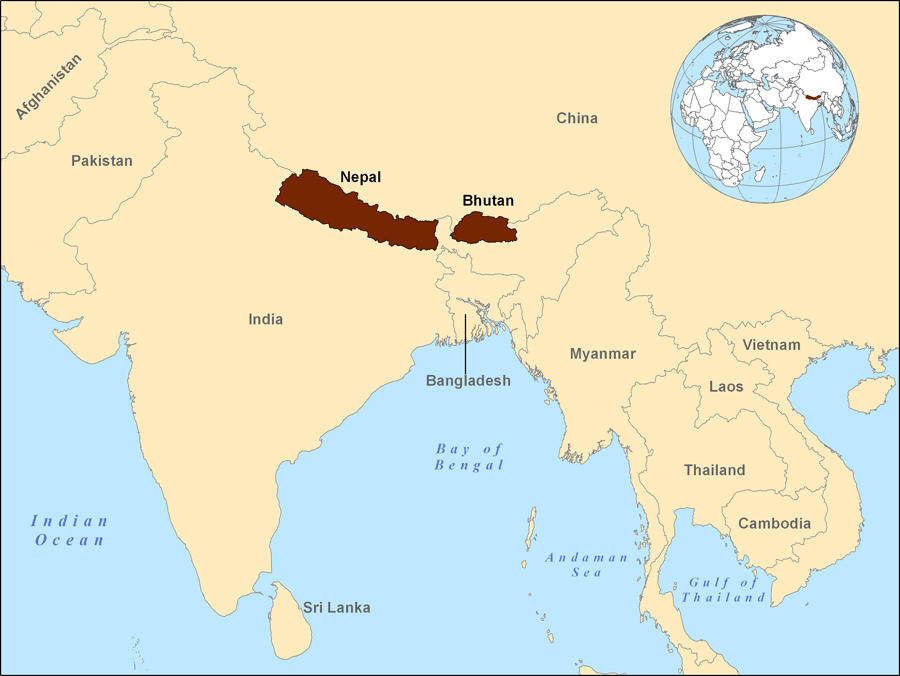Background
Bhutanese Refugee Health Profile
Group Origins
Bhutan is located in the Himalayan Mountains between India and China (Figure 1). The ethnically Nepali, Nepali-speaking Bhutanese, or Lhotsampas (“People of the south”), are a largely Hindu people who moved from Nepal to Bhutan. They lived peacefully in Bhutan until the mid-1980s when Bhutan’s king and the ruling Druk majority feared that their population could overrun the majority group and dilute the traditional Buddhist culture of the Druk Bhutanese. 1 A cultural campaign known as “One country, one people,” or “Bhutanization,” was initiated in order to forge a Bhutanese national identity. The policies forced the Druk dress code, religious practices, and language on all Bhutanese regardless of heritage. These adopted policies alienated the Lhotsampas by attempting to forcibly integrate them into the majority culture. 1 Difficult requirements for proving citizenship were also imposed on the Lhotsampa people, and even those who could provide documentation were usually denied citizenship. 1 Human rights violations were commonplace and by the early 1990s, the “One country, one people” campaign had precipitated a humanitarian emergency. By 1993, more than 100,000 Lhotsampa Bhutanese had fled or were forced out of Bhutan and resettled in southeastern Nepal.
Figure 1: Location of Nepal and Bhutan

Language and Literacy
The majority of Bhutanese refugees are bilingual. Most speak Nepali at home, but some also speak the Bhutanese language, Dzongkha. 1 Younger members of the refugee community have also been exposed to English in the camps in Nepal. The Office of the United Nations High Commissioner for Refugees (UNHCR) estimates that about 35% of refugees in Nepali camps have a functional grasp of English. 3 Among the older refugees, those not born in camps, men speak more English than women. 4 Nepali interpreters, however, were required for nearly 90% of Bhutanese refugee post-arrival medical screening examinations carried out from 2008-2011 in Texas. 15 Among Bhutanese refugees, the literacy rate in their native language is estimated at 65%. 5
Religious Beliefs
Approximately 60% of the refugees are Hindu, 27% are Buddhists, 10% are Kirat (an indigenous animistic faith), and the remaining refugees are Christian. 3
Caste System
Bhutanese refugees follow a complex caste system very similar to that of their Nepalese counterparts. In the refugee camps, there are a total of 64 castes, groups, and parties. 4 The Hindus have four castes, of which Bahun is the highest. In the refugee camps in Nepal and in U.S. communities after resettlement, caste has been declining in importance for many people, while still retaining its value for others. Those who still adhere to the social and behavioral rules of the caste system are unlikely to discuss it openly with outsiders. 1
Family and Kinship
The typical household is large and often includes elderly parents, married sons and their wives and children, and unmarried children. 3 The younger generation is generally responsible for the care of older relatives, reflecting the tradition of respecting one’s elders, regardless of relation. 1 It is common for family disputes, health problems, and financial troubles to be brought to discussions with the elders within the family before action is taken. The Bhutanese community as a whole is tightly-knit, and kinship ties are important. 1
Gender Roles
In Bhutan and in refugee camps in Nepal, gender roles are clearly demarcated. Females perform far more housework, have less access to information and resources, and usually have less decision-making power than males. 3 In some castes, female victims of sexual violence and their families can face alienation from their community.
Cultural Approach to Health Care
Bhutanese refugees often use home remedies as first-line treatment for illness and seek outside medical advice only if their symptoms are not relieved. 1 Traditional healers, called dhami-jakhri, also continue to play a role in health care for many resettled refugees. Patients may need encouragement and positive reinforcement to feel comfortable sharing their use of traditional practices with American providers. Bhutanese refugees tend to seek out care in response to a serious health problem rather than seeking preventive care. The reluctance of the community to seek care unless severely ill may be amplified by the fact that refugees may not have adequate health coverage after the eight-month period of federal resettlement benefits ends, and may be unable to meet the financial costs of medical care. 1 Health care utilization is also affected by traditional gender roles, as mothers may be hesitant to describe their own health concerns but will voice the health concerns of their children or spouse. 4
Additional Resources
For more information about the orientation, resettlement, and adjustment of Bhutanese refugees visit the Cultural Orientation Resource Center.
References
- Maxym M, et al. Nepali-speaking Bhutanese (Lhotsampa) cultural profile. 2010. http//www.ethnomed.org. Accessed 12 Mar 2011.
- Ranard D. (2007). Bhutanese refugees in Nepal. Center for Applied Linguistics. http://www.cal.org/co/pdffiles/backgrounder_bhutanese.pdf
- International Rescue Committee (2009). The health of refugees from Bhutan. IRC New York.
- International Organization for Migration (IOM).
- Texas Department of State Health Services (2009-2011), Electronic System for Health Assesment of Refugees (eShare Database).
- Page last reviewed: June 22, 2012
- Page last updated: February 24, 2014
- Content source:


 ShareCompartir
ShareCompartir